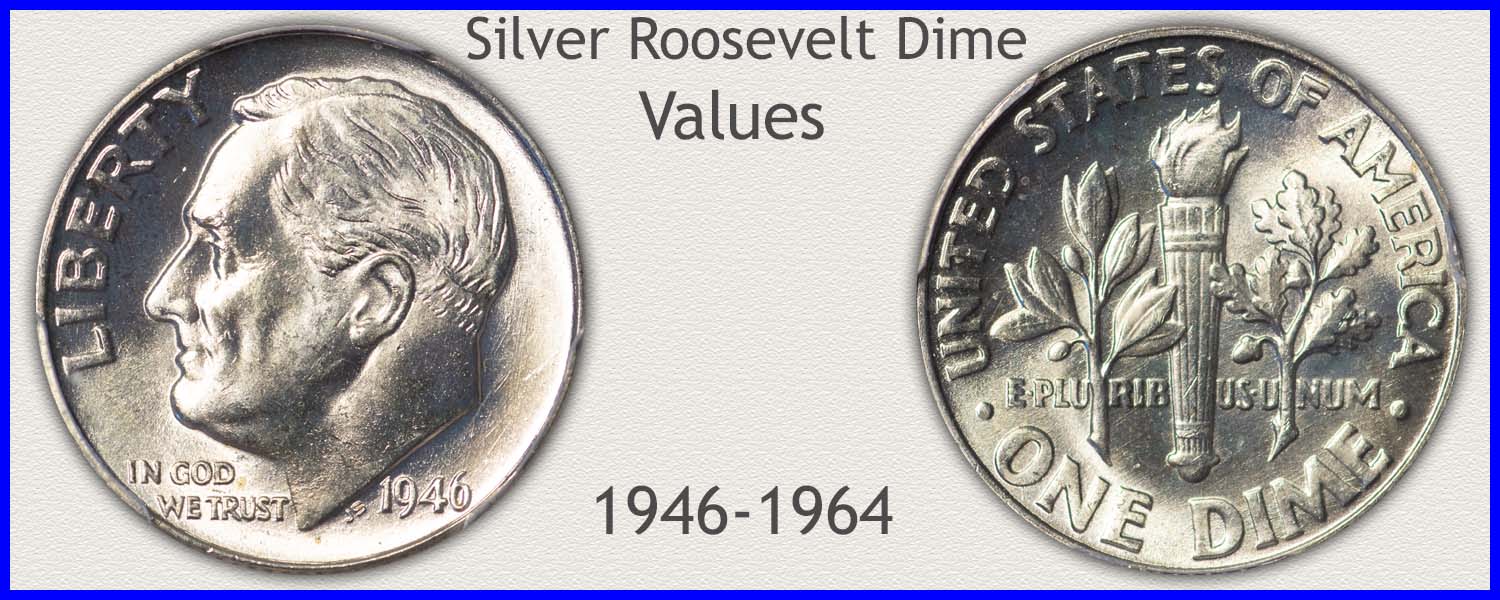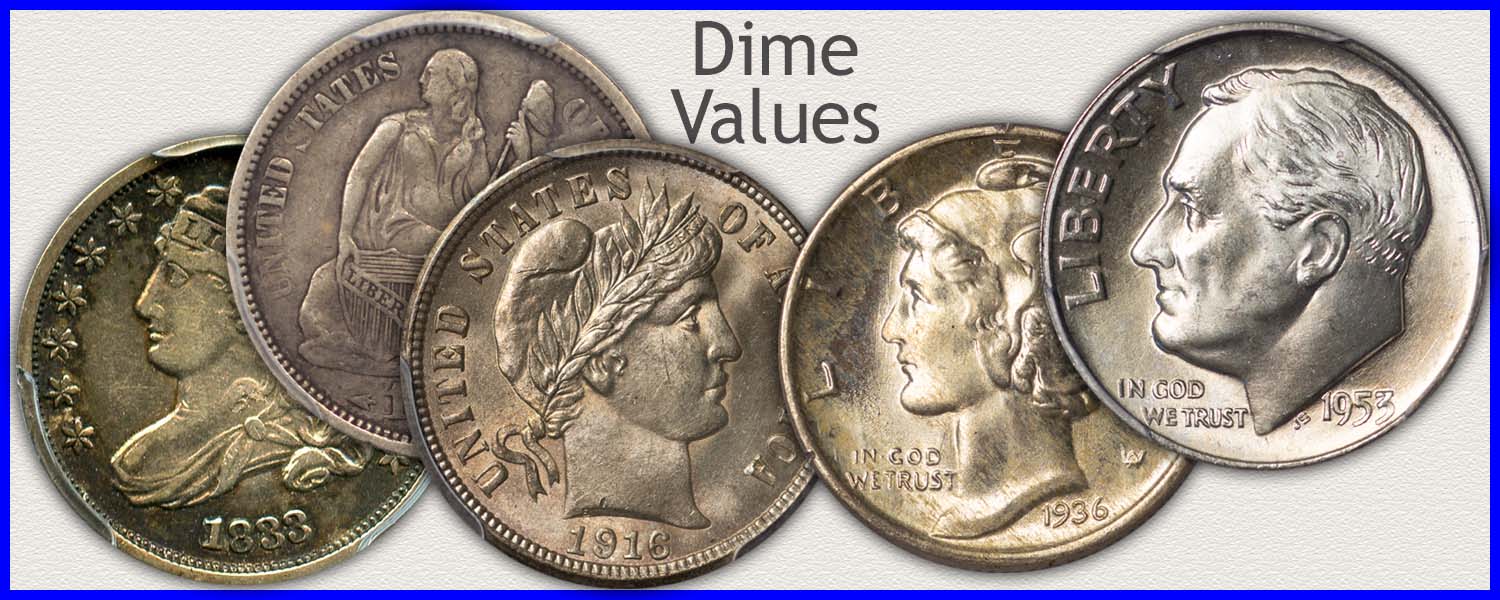Coin Values Moving with Precious Metals: Up-Dated 4/14/2025: Gold $3226 | Silver $31.88
1961 Dime Value
1961 dime value begins with its high silver content. Roosevelt dimes of the early 1960's are a 90% silver alloy. Each is worth $2.13 as of 4/14/2025 .
Mint varieties and condition are also identified to arrive at its place on the value chart. Collectors assemble sets of these vintage dimes including all dates/mints, plus an eye towards high condition examples. Following a few steps, comparing to images, and taking a close look at each coin separates the collectible quality examples.
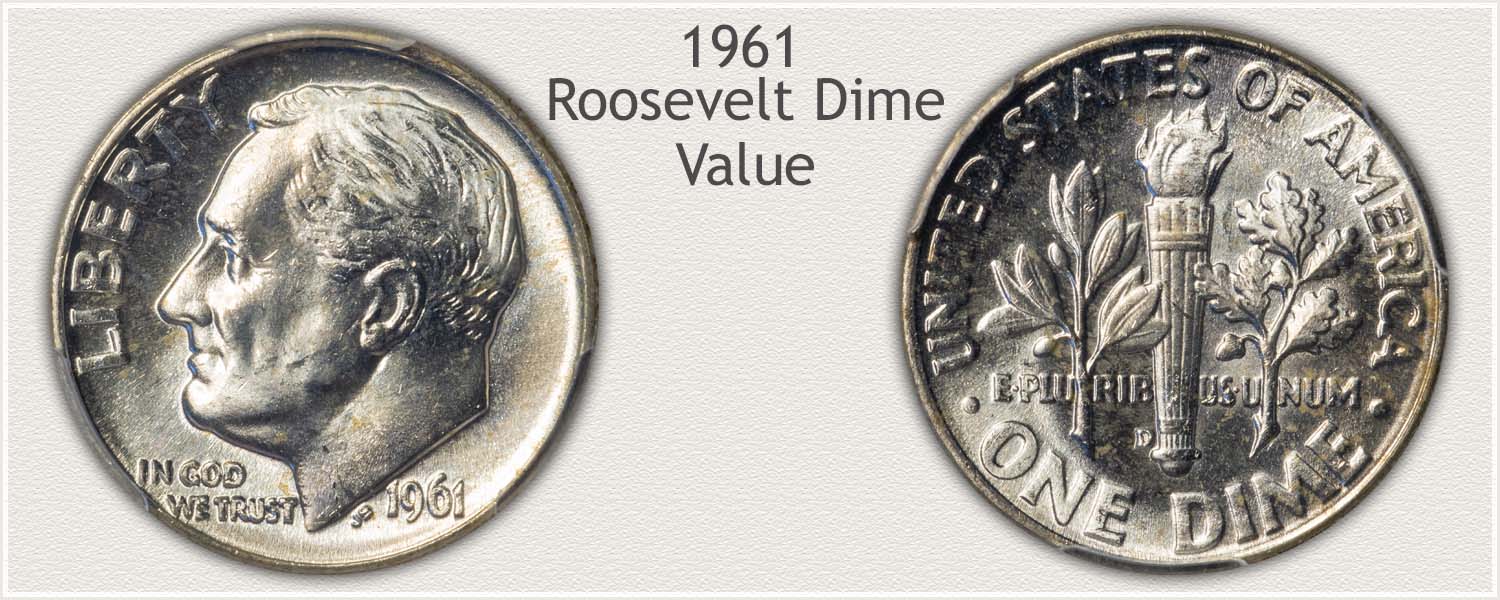
Steps Leading to Value:
- Step 1: Date and Mintmark Variety - Confirm your dime variety. Each date plus mint variety is collected and valued individually. Listings on the chart show demand and scarcity of each date and mint.
- Step 2: Grading Condition - Judging condition identifies the quality trading at base silver price and separates the coins considered premium collectibles.
- Step 3: Special Qualities - Certain qualities are considered by collectors when assembling sets of these vintage Roosevelt dimes. Key factors to notice help narrow the standout examples.
| 1961 Dime Value | ||||
|---|---|---|---|---|
| Condition of Coin | ||||
| Date | Good | Fine | Extremely Fine | Mint State |
| Roosevelt Dime Values Updated | 4/14/2025 | |||
| 1961 | $2.13 | $2.13 | $2.13 | $2.63 |
| 1961 D | $2.13 | $2.13 | $2.13 | $2.63 |
Examine your coin closely, the more detail seen on the surface the higher potential. Following the steps below and comparing to the images helps see the premium qualities needed to place a Roosevelt dime above minimum silver value.
Step 1: | Date and Mintmark Variety Confirmed
Date and Mints of 1961 Dimes Listed on Chart
A need for coinage and specifically the dime denomination required a total of 302.8 million pieces in 1961. Two mints stuck these dimes and each variety is listed on the chart and collected separately. 1961 is among the abundant production years of the Roosevelt series.
Mintmarks are how each mint's production is identified.
1961-D Roosevelt Dime
"D" Mintmark on Reverse: Denver Mint Struck the Coin
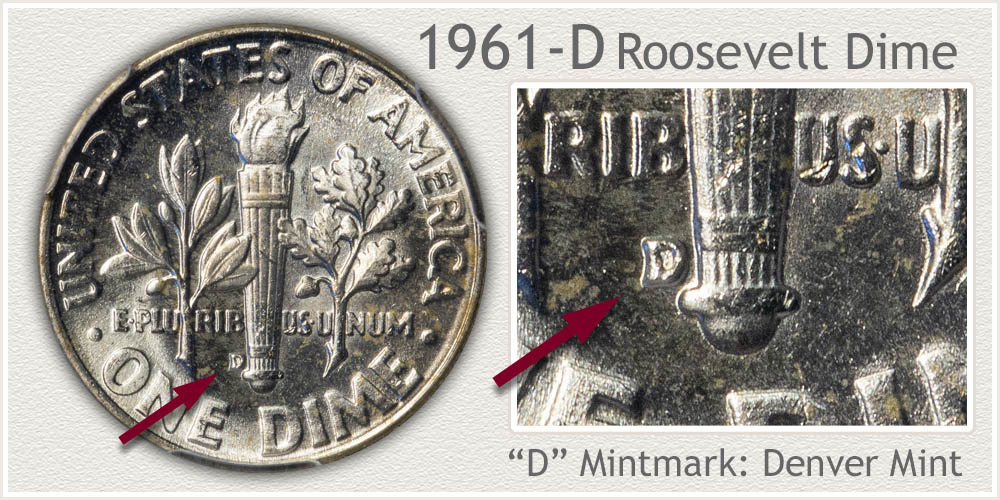
Denver mint was the largest contributor to U.S. coinage in 1961 producing the majority of not only dimes, but the rest of the denominations - cents to half dollars. With the large number released; over 209 million dimes, these remain available today. Silver value is the base, premiums above silver are found in collector grades within the mint state categories.
Denver mint issues are mint marked with a small "D" mark found on the reverse. At the base of the torch, on the left a "D" mintmark identifies the Denver dime.
1961 Roosevelt Dime
No Mintmark on Reverse: Philadelphia Mint Struck the Coin
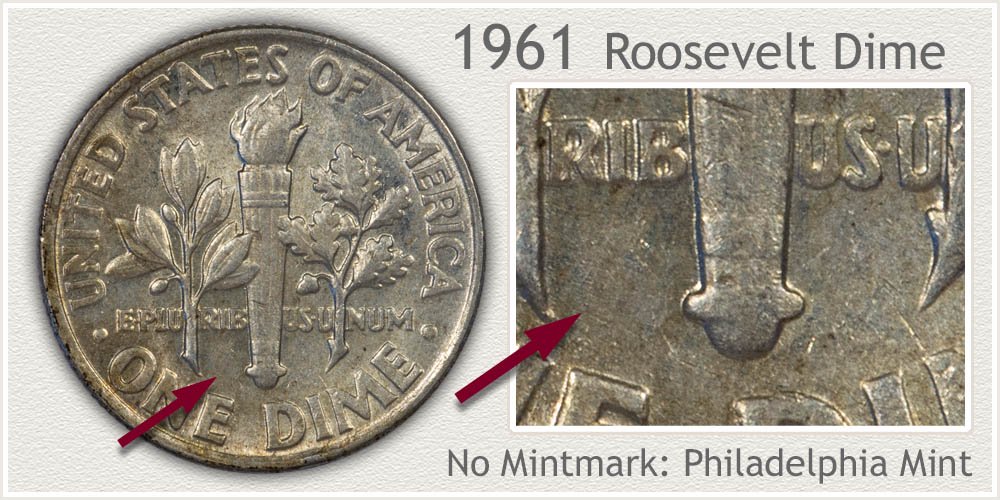
The Philadelphia mint is the original mint of the U.S. Its duties included coin production, assay office and metal refining. 1961 minting of dimes topped 93 million pieces, ample for the time and allowing many to remain today. Worn examples trade based on their silver content. A high condition, mint state coin with-out any signs of wear is the premium collector quality.
Philadelphia did not use mintmarks to identify production in the early 1960's. On the reverse, the space is empty of a mintmark on the left side of the torch. Absence of a mark confirms the Philadelphia issue.
Step 2: | Judge Condition to Identify Grade
1961 Dime Value is Conditional
Many 1961 Roosevelt dimes exist today. If is from this quantity the few remaining in very well-preserved condition are in demand by collectors. High quality pieces are awarded a premium above their base silver value.
Grading is the process to separate and define the condition of a coin. Standards for the grades are imaged and used to compare your coin. Finding a close match and a focus on the key areas described, narrows the condition to a grade. These grades are listed on charts along with date and mintmark combinations.
Handle your coins by the edges over a soft surface. This helps preserve quality of high grade coins.
Mint State Grade
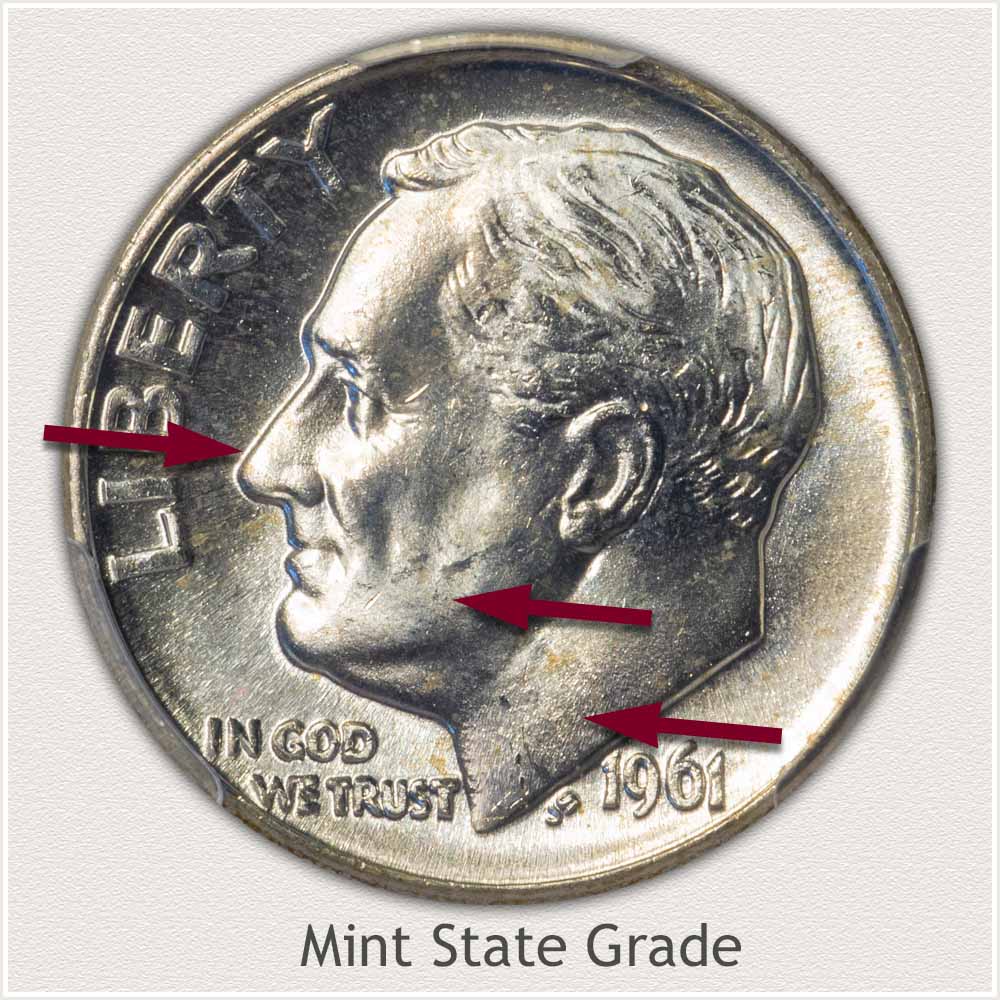
Mint State: Identifying a coin without any wear to the surface is a mint state example. No wear, is the key to this collectible grade.
Wear first appears as the removal of original mint luster from the surface. This is a delicate texture imparted to the metal during the minting process, producing the shine. An inspection of the highest areas of design is needed confirm no wear.
Roosevelt's cheek just below the eye is an area to focus on to determine the mint state grade. Notice on the example image, bright luster covers the cheek. Texture and luster of the cheek matches the metal in the low relief area between the cheek and jaw. Any wear dulls both the shine and color of the metal and wear smooths the surface.
Luster, color, and texture is similar over the entire coin. No dull spots, no breaks in the luster when tilted to light, and no smooth areas is confirming the mint state grade.
Extremely Fine Grade
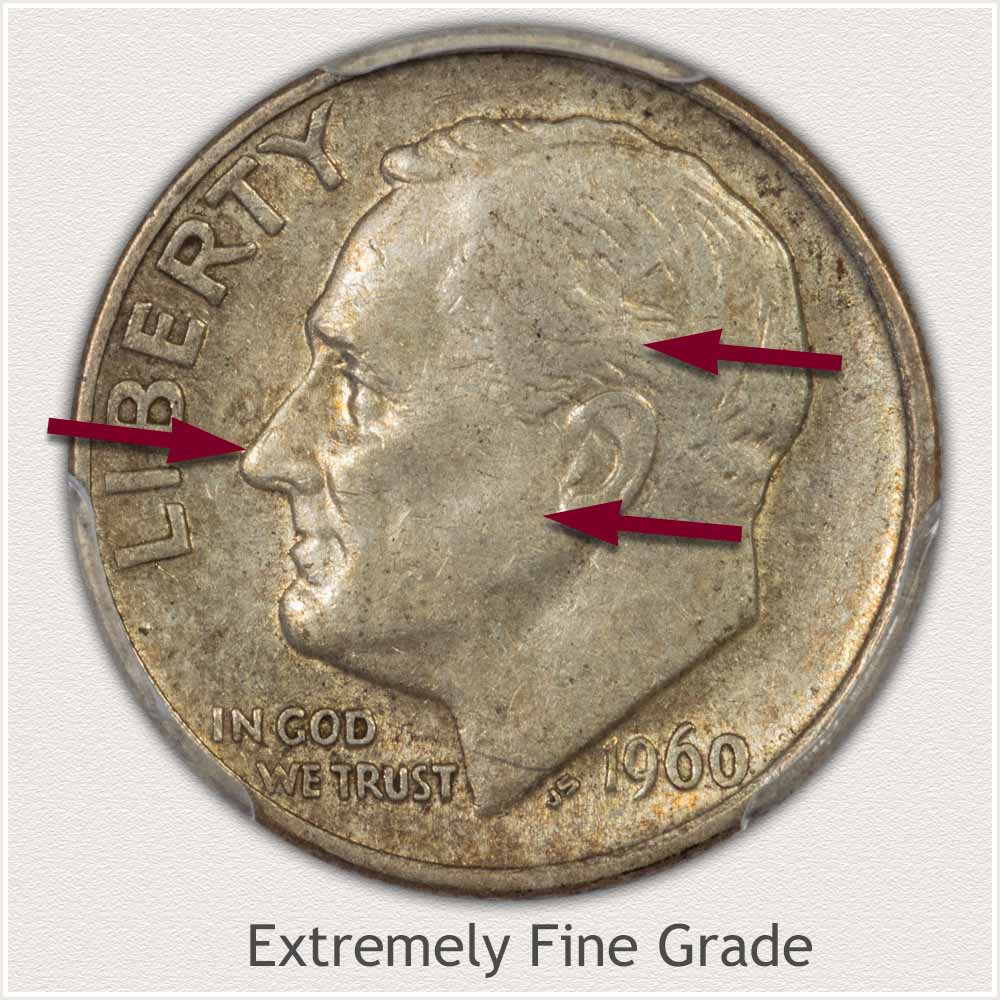
Extremely Fine: A visual change to a dime occurs when it receives light wear to the surface. If wear is only on the highest areas and slight, the grade is Extremely Fine.
Wear causes the surface of the metal to become smooth and these areas are a slightly different color tone. Inspecting the cheek area below the eye, a smoothness is seen with the metal just beginning to show a flat area. A soft grey is now the color of the worn area replacing the white-silver of luster.
Hair strands remain well detailed indicating wear is slight and the extremely fine grade.
Low Grade Examples
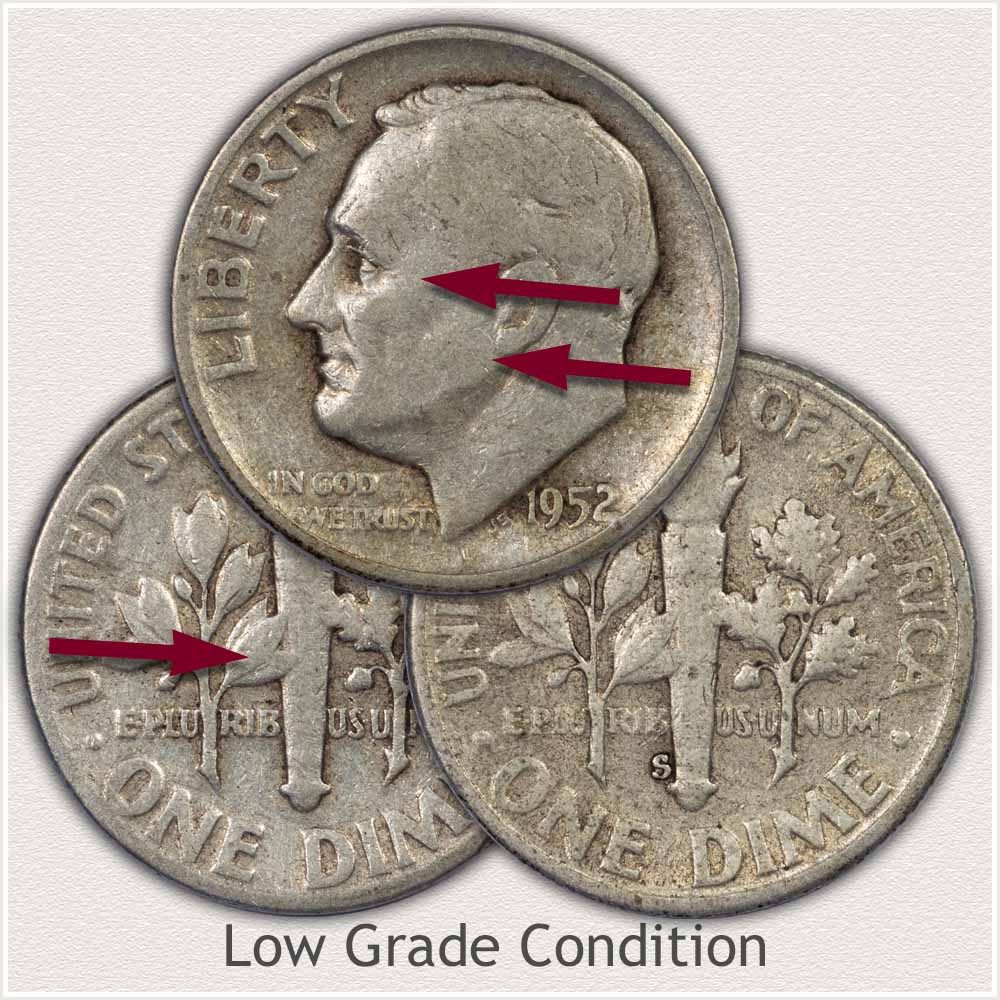
Low Grade Condition: Wear removes the fine details and lowers eye appeal of Roosevelt dimes. Moderate to heavy wear continues to reduce the design with large flat areas replacing the high contoured reliefs. Low grade is a visibly worn coin.
Roosevelt's cheek is now a flat spot below the eye. The cheek and jaw are both flat in profile and beginning to connect. A distinction of the hair line and forehead is faded. Additionally, lack of fine lines in the hair is placing the example coins below extremely fine and into low grade.
How to Video: Grading Roosevelt Dimes
A few moments spent looking closely at these silver dimes begins to see the different levels of wear and condition.
Video, Images and Descriptions | Grading Roosevelt Dimes
Step 3: | Special Qualities Enhancing Value
A Close Focus on Quality of a Coin's Surface
1961 dimes recorded the sixth highest mintage total of the silver Roosevelt era. With the huge number of 302 million struck it requires a very nice condition coin to become a sought-after collectible. These coins are also one of the years many were quickly removed from circulation and saved because of silver content. Supplies available is not the difficulty of finding an example, high condition is the key to premium value.
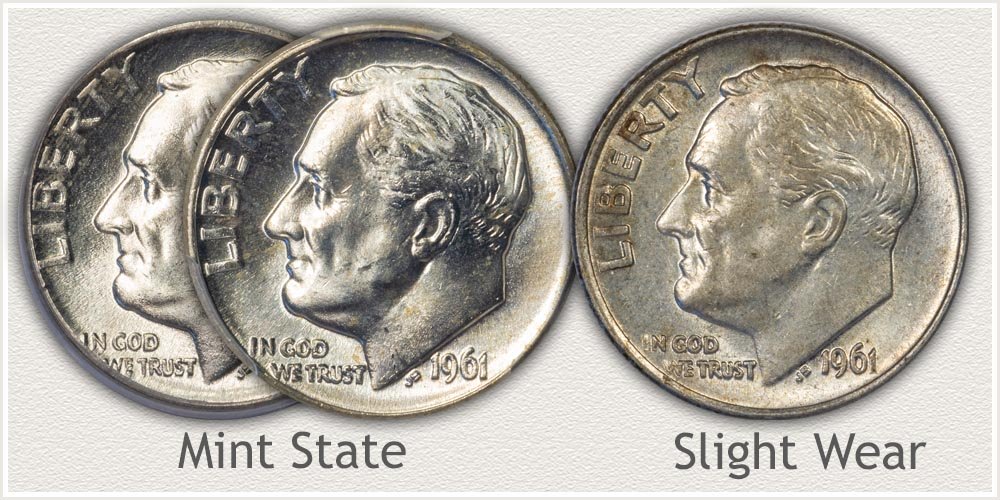
With so many removed from circulation soon after minting the overall condition of 1961 dimes is towards the lightly circulated grades. A high number of these dimes just miss the collectible mint state grade. The first two coins are solid mint state condition, the third is an example with very slight wear. Overall appearance of the three is similar at first look. It is now, a close inspection of the worn coin is required to spot the traces of wear.
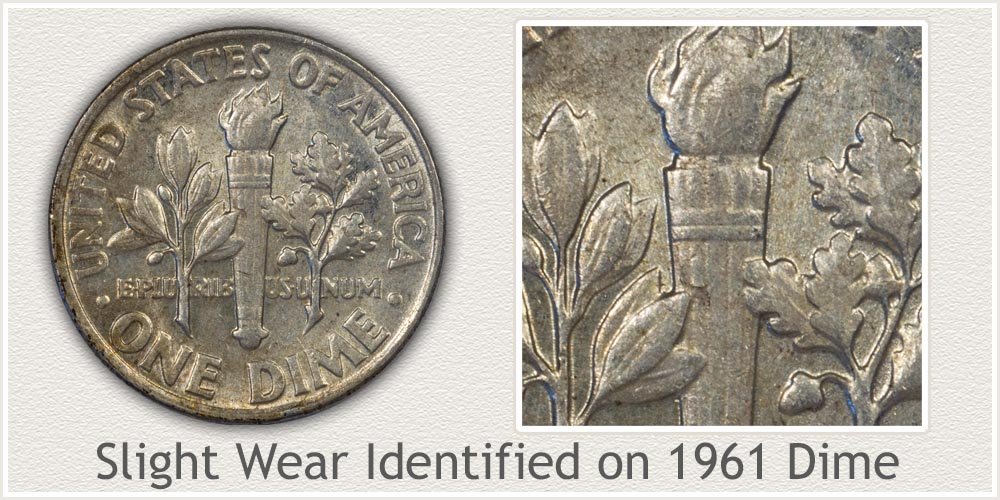
Identifying this dime lower than mint state grade is the wear on the very highest points. An examination of the reverse with a focus on the leaves and central area of the torch, spots evidence of wear. The majority of the surface of the dime is covered in original luster giving it a nice appearance. It is the traces of dulling on the high points of concern.
Looking at the edges of the olive leaves, a dull grey color is seen on the high contour edges. Wear has removed the luster and smoothed the metal along the lines of the leaves. Lower protected areas remain with luster giving a contrast and helping see the difference.
Another area to judge is the center of the torch and vertical lines. High and low relief metal forms the lines and in the example, high points are dull and slightly smooth. Luster and shine remain in low protected areas. A contrast of color and texture is indicating wear.
The strict definition of Mint State Grade is: no wear to the surface. Judging the condition of the very small high points of the reverse is needed to confirm a true mint state coin. Use a single light source and view the coin at different angles to the light helping bring out any signs of wear.
References
U.S. Mint. 1962 U.S. Mint Annual Report. https://nnp.wustl.edu/library/book/519619
Coin Values | CoinStudy Articles
Date by Date
In Depth Roosevelt Dime Values
1946 to 1964
Roosevelt Dime Values | Early Silver Era
Roosevelt dime values of the early silver years, 1946 to 1964 are a premium coin because of silver content. These early dimes are 90% silver and move with the price of precious metals. Currently worth $2.13 each. Dates and mint varieties are listed on value charts with a step-by-step process to determine condition and how much they are worth.
Discover how much your old dimes are worth. Early series of the Bust and Seated Liberty dimes to Barber, Mercury, and Roosevelt Dimes. Follow a few steps to identify variety, date, and comparing your coins to images and descriptions judge condition and grade. Narrow the range of how much they are worth on value charts.
An insight into what is collected today, what is popular, and numbers of collectors involved helps show Roosevelt dimes are a series in demand. Coin series spanning all denominations are charted and ranked by numbers of collectors assembling sets of U.S. coins.
Safe Coin Storage | Recommendations
Thoughtful coin storage to improve safe handling, preserve value, and organize your box of old coins. A few basic supplies are highlighted that provide long term protection. Safe storage of silver coins maintains their state of preservation into the future.
An easy reference guide to U.S. coin values. Charts with minimum values quickly finds starting values. Images identify the different series and dates. Links to extended charts listing varieties, grading ranges and images helping determine condition - grade of coins. On the go, bookmark to phone.
★Coin Values Discovery finds 1961 Dime Value and...
All old U.S. coin values. Image and description index leading to value charts. Step by step method to date and variety identification. And grading condition by comparing to images, video and descriptions. Special qualities are also judged. Discover how much your box of old coins is worth.
